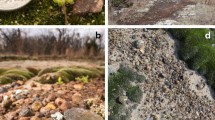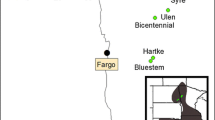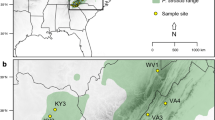Abstract
Mexican spruce (Picea mexicana Martínez), an endangered species of the highest sky islands in México's Sierra Madre Oriental and Sierra Madre Occidental, is threatened by fire, grazing, and global warming. Its conservation depends on whether it also is threatened by inbreeding and loss of genic diversity. We used 18 isozyme markers in 12 enzyme systems to assay genic diversity, characterize the mating system, and test for recent bottlenecks in three known populations. Unbiased, expected heterozygosity (H e ) averaged 0.125. Despite a separation of 676 km between populations in the Sierra Madre Oriental and the Sierra Madre Occidental, Wright's F ST , the proportion of total genic diversity among populations, was only 6.9%. Nei's genetic distance was 0.001 between the populations in the Sierra Madre Oriental and more than an order of magnitude greater, 0.019, between the Sierra Madre Oriental and Sierra Madre Occidental. However, both values point to relatively recent divergence. Mating systems were predominantly outcrossing, but with significant selfing. Multilocus estimates of selfing varied from 19% to 41%, and the means of single-locus estimates were higher, suggesting that additional inbreeding occurred by mating among relatives. Despite significant inbreeding, observed heterozygosity was as high as or higher than H e ; Wright's fixation index, F IS , was −0.107. Under the observed level of selfing, positive values of F IS were expected. Therefore, selection against inbreds and homozygotes must be intense. Cornuet-Luikart tests indicate recent bottlenecks in at least two of the three populations. The results suggest that Mexican spruce is a genetically viable species, and threats are primarily environmental.
Similar content being viewed by others
References
Allard RW, Jain SK, Workman PL (1968) The genetics of inbreeding populations. Adv. Genet., 14, 55–131.
Bye R (1993) The role of humans in the diversification of plants in Mexico. In: Biological Diversity of Mexico: Origins and Distribution (eds. Ramamoorthy TP, Bye R, Lot A, Fa J), pp. 707–731. Oxford University Press, NY-Oxford.
Capó-Arteaga M, Valencia-Manzo S, Flores-López C, Braham-Sabag S (1997) Informe Final de Actividades del Proyecto: Autoecología del Género Picea en Nuevo León. Presentado a: Consejo Consultivo Estatal para la Preservación y Fomento de la Flora y Fauna Silvestre de Nuevo León. Univ. Autónoma Agraria Antonio Narro, Buenavista, Saltillo, Coahuila.
Clisby KH, Sears PB (1955) Palynology in southern North America. Part III: Microfossil profiles under Mexico City correlated with the sedimentary profiles. Bull. Geol. Soc. Amer., 66, 511–520.
Conkle MT (1981) Isozyme variation and linkage in six conifer species. In: Proceedings of the Symposium on Isozymes of North American Forest Trees and Forest Insects, July 27, 1979, Berkeley, California (tech. coord. Conkle MT), pp. 11–17. USDA For. Serv., Pacific Southwest For. and Range Exp. Sta., General Tech. Rep. PSW-49, Berkeley, California.
Conkle MT, Hodgskiss PD, Nunnally LB, Hunter SC (1982) Starch Gel Electrophoresis of Pine Seed: A Laboratory Manual. USDA For. Serv. Pacific Southwest For. and Range Exp. Sta., General Tech. Rep. PSW-64, Berkeley, California.
Correll DS (1960) A mule-train trip to Sierra Mohinora, Chihuahua. Amer. Fern J., 50, 66–78.
Cornuet JM, Luikart G (1996) Description and power analysis of two tests for detecting recent population bottlenecks from allele frequency data. Genetics, 144, 2001–2014. 122
Critchfield WB (1984) Impact of the Pleistocene on the genetic structure of North American conifers. In: Proceedings of the Eighth North American Forest Biology Workshop (ed. Lanner RM), pp. 70–118. Depart. For. Resources, Utah State Univ., Logan, Utah.
Farjon A, Page CN (compilers) (1999) Conifers. Status Survey and Conservation Action Plan. IUCN/Species Survival Commission Conifer Specialist Group, International Union for Conservation of Nature and Natural Resources, Gland, Switzerland.
Fowler DP, Morris RW (1977) Genetic diversity in red pine: Evidence for low genic heterozygosity. Can. J. For. Res., 7, 343–347.
Franklin EC (1970) Survey ofMutant Forms and Inbreeding Depression in Species of the Family Pinaceae. USDA For. Serv., Southern For. and Range Exp. Sta., Res. Pap. SE-61, New Orleans, Louisiana.
Gilpin ME, Soulé ME (1986) Minimum viable populations: Processes of extinction. In: Conservation Biology: The Science of Scarcity and Diversity (ed. Soulé ME), pp. 19–34. Sinauer Associates, Sunderland, Massachusetts.
Gordon AG (1991) Genetics, genecology and breeding in the genus Picea L. (spruce). In: Proceeding of the Twenty-third Meeting and Activity Reports of the Canadian Tree Improvement Association, August 19–23 (eds. Magnussen S, Lavereau J, Boyle TJ), pp. 86–88. Ottawa, Ontario.
Gordon AG (1990) Supplementing the population restoration of Picea mexicana in Nuevo Leon, Mexico. XVII Meeting of the Tree Improvement Study Group, North American Forestry Commission, Food and Agricultural Organization of the United Nations. Chapingo, Mexico (manuscript).
Graham A (1993) Historical factors and biodiversity in Mexico. In: Biological Diversity of Mexico: Origins and Distribution (eds. Ramamoorthy TP, Bye R, Lot A, Fa J), pp. 109–127. Oxford University Press, NY-Oxford.
Hamrick JL, Godt MJW (1996) Effects of life history traits on genetic diversity in plant species. Phil. Trans. Roy. Soc. Lond. B, 351, 1291–1298.
Hamrick JL, Godt MJW, Sherman-Broyles SL (1992) Factors influencing levels of genetic diversity in woody plant species. New Forests, 6, 95–124.
Kimura M, Crow JF (1964) The number of alleles that can be maintained in a finite population. Genetics, 49, 725–738.
Ledig FT (1998) Genetic variation in Pinus. In: Ecology and Biogeography of Pinus (ed. Richardson DM), pp. 251–280. Cambridge University Press, Cambridge.
Ledig FT (2000) Founder effects and the genetic structure of Coulter pine. J. Hered., 91, 307–315.
Ledig FT, Mápula-Larreta M, Bermejo-Velázquez B, Flores-López C, Reyes-Henández V, Capó-Arteaga MA (2000a) Locations of endangered spruce populations in México and the demography of Picea chihuahuana. Madroño, 47, 71–88.
Ledig FT, Bermejo-Velázquez B, Hodgskiss PD, Johnson DR, Flores-López C, Jacob-Cervantes V (2000b) Mating system and genic diversity in Martínez spruce, an extremely rare endemic of México's Sierra Madre Oriental: An example of facultative selfing and survival in interglacial refugia. Can. J. For. Res., 30, 1156–1164.
Ledig FT, Jacob-Cervantes V, Hodgskiss PD, Eguiluz-Piedra T (1997) Recent evolution and divergence among populations of a rare Mexican endemic, Chihuahua spruce, following Holocene climatic warming. Evolution, 51, 1815–1827.
Lozano-García MS, Ortega-Guerrero B, Caballero-Miranda M, Urrutia-Fucugauchi J (1993) Late Pleistocene and Holocene paleoenvironments of Chalco Lake, central Mexico. Quaternary Res., 40, 332–342.
Luikart G, Cornuet J-M (1998). Empirical evaluation of a test for identifying recently bottlenecked populations from allele frequency data. Conserv. Biol., 12, 228–237.
Martínez M (1961) Una nueva especie de Picea in México. Anales del Instituto de Biología de la Universidad Nacional de México, 32, 137–142.
McDonald JA (1993) Phytogeography and history of the alpinesubalpine flora of northeastern Mexico. In: Biological Diversity of Mexico: Origins and Distribution (eds. Ramamoorthy TP, Bye R, Lot A, Fa J), pp. 681–703. Oxford University Press, NY-Oxford.
Nei M (1978) Estimation of average heterozygosity and genetic distance from a small number of individuals. Genetics, 89, 583–590.
Piry S, Luikart G, Cornuet J-M (1999) BOTTLENECK: A computer program for detecting recent reductions in the effective population size using allele frequency data. J. Hered., 90, 502–503.
Ritland K (1986) Joint maximum likelihood estimation of genetic and mating structure using open-pollinated progenies. Biometrics, 42, 25–43.
Ritland K (1989) Correlated matings in the partial selfer Mimulus guttatus. Evolution, 43, 848–859.
Ritland K (1990a) Generalized Multilocus Estimation Program MLTF. K. Ritland, Toronto, Ontario.
Ritland K (1990b) A series of FORTRAN computer programs for estimating plant mating systems. J. Hered., 81, 235–237.
Ritland K (1994) Multilocus Mating System Program MLTR, version 0.9. K. Ritland, Depart. Bot., Univ. Toronto, Toronto, Ontario.
Rushforth K (1986) Mexico's spruces – rare members of an important genus. Kew Magazine, 3, 119–124.
Saccheri I, Kuussaari M, Kankare M, Vikman P, Fortelius W, Hanski I (1998) Inbreeding and extinction in a butterfly metapopulation. Nature, 392, 491–494.
Slatkin M, Barton NH (1989) A comparison of three indirect methods for estimating average levels of gene flow. Evolution, 43, 1349–1368.
Swofford DL, Selander RB (1981) BIOSYS-1: A FORTRAN program for the comprehensive analysis of electrophoretic data in population genetics and systematics. J. Hered., 72, 281–283.
Taylor RJ, Patterson TF (1980) Biosystematics of Mexican spruce species and populations. Taxon, 29, 421–469.
Taylor RJ, Patterson TF, Harrod RJ (1994) Systematics of Mexican spruce – revisited. System. Bot., 19, 47–59.
Westemeier RL, Brawn JD, Simpson SA, Esker TL, Jansen RW, Walk JW, Kershner EL, Bouzat JL, Paige KN (1998) Tracking the long-term decline and recovery of an isolated population. Science, 282, 1695–1698.
Wright S (1951) The genetical structure of populations. Ann. Eugen., 15, 323–354.
Wright S (1965) The interpretation of population structure by Fstatistics with special regard to systems of mating. Evolution, 19, 395–420.
Yeh FC (1988) Isozyme variation of Thuja plicata (Cupressaceae) in British Columbia. Biochem. System. Ecol., 16, 373–377.
Author information
Authors and Affiliations
Corresponding author
Rights and permissions
About this article
Cite this article
Ledig, F.T., Hodgskiss, P.D. & Jacob-Cervantes, V. Genetic diversity, mating system, and conservation of a Mexican subalpine relict, Picea mexicana Martínez. Conservation Genetics 3, 113–122 (2002). https://doi.org/10.1023/A:1015297621884
Issue Date:
DOI: https://doi.org/10.1023/A:1015297621884




